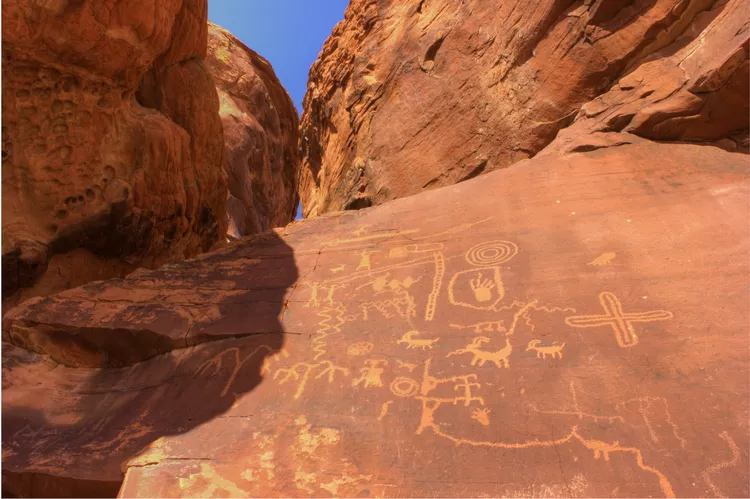Summary
Exploring Prehistoric Indian Petroglyphs and Pictographs
Nevada is a key location for viewing ancient Native American rock art in the form of petroglyphs and pictographs, much of it dating back thousands of years. Some of the most significant and well-preserved sites in the state are located in easily accessible areas. Other notable rock art sites can be found throughout the southwestern United States.
The dry desert climate and sparse population in Nevada have significantly contributed to the preservation of these artifacts of prehistoric life in the Great Basin. Both northern and southern regions host numerous rock art sites that are open to the public.
When visiting these remarkable rock art sites, it is crucial to maintain a respectful distance and avoid climbing on or touching the art. Although they may appear durable, even the oils from your fingers can damage the details that have survived for millennia. Binoculars offer an excellent way to appreciate the art up close, and a telephoto lens is ideal for capturing its beauty in photographs. Remember that rock art sites are invaluable cultural treasures protected by law.
What is Native American Rock Art?
Rock art exists in two primary forms – petroglyphs and pictographs. The differentiation arises from the techniques used to create each type.
Petroglyphs are formed by removing pieces of rock from a surface. The artist might have pecked, scratched, or scraped the outer layer to create the desired pattern. Petroglyphs typically stand out against rock surfaces that have darkened over time due to patination, a natural aging process often called “desert varnish.” Over time, however, these petroglyphs may become less visible as patina develops on the newly exposed rock surfaces.
Pictographs, on the other hand, are “painted” onto rock surfaces using various pigments, such as ocher, gypsum, and charcoal. Some pictographs were created with organic materials, including blood and plant sap. Artists applied pigments using fingers, hands, or perhaps sticks designed to mimic brushes. While archaeological dating methods have been utilized to determine the age of organic materials in petroglyphs, there have been limited studies of such types in Nevada.
The meaning of rock art remains elusive, as no definitive answers exist. Numerous theories have emerged, ranging from symbols representing religious beliefs to those aimed at ensuring successful hunting. Until a breakthrough occurs that decodes these ancient messages, the true purpose of rock art will remain a fascinating mystery.
Rock Art Sites in Northern Nevada
The Grimes Point Archaeological Area is arguably the most accessible rock art site in northern Nevada. Situated adjacent to U.S. Highway 50, approximately seven miles east of Fallon, it offers a paved parking lot, sheltered picnic tables, restroom facilities, and several interpretive signs. A self-guided trail meanders through this area, featuring a wealth of petroglyphs, with signs providing insights into the rock art display. This path was designated Nevada’s first National Recreation Trail in 1978.
The Hidden Cave Archaeological Area lies a short drive from Grimes Point via a well-maintained gravel road. Visitors may hike an interpretive trail, though public access to the cave itself is restricted due to its sensitive archaeological nature, which remains an active site for excavation and research. Free guided tours occur on the second and fourth Saturdays of each month, starting at 9:30 a.m. from the Churchill County Museum, located at 1050 S. Maine Street, Fallon. After a video presentation about Hidden Cave, a BLM guide leads participants to the site. This tour is free, and reservations are unnecessary. For additional details, please contact (775) 423-3677.
Lagomarsino Canyon stands as one of the largest rock art sites in the state, showcasing over 2,000 petroglyph panels. The site’s significance is emphasized by its inclusion in the National Register of Historic Places, making Lagomarsino Canyon crucial for the study of Great Basin rock art. The Nevada Rock Art Foundation, Storey County, the Nevada State Museum, and other organizations have spearheaded documentation, graffiti removal, and preservation efforts.
Much has been documented about the petroglyphs at Lagomarsino Canyon and what they reveal concerning the prehistoric human populations that inhabited the Great Basin. For those seeking deeper insights, the Nevada Rock Art Foundation Public Education Series No. 1 and the Lagomarsino Canyon Petroglyph Site from the Bradshaw Foundation are excellent resources.
Lagomarsino Canyon is located in the Virginia Range, east of Reno/Sparks and north of Virginia City, making it surprisingly proximate to populated areas yet somewhat challenging to access via rugged backcountry roads.
Rock Art Sites in Southern Nevada
Southern Nevada is home to an abundance of rock art sites. One of the most famous and easily reachable is located in Valley of Fire State Park, approximately 50 miles east of Las Vegas. Valley of Fire holds the title of Nevada’s oldest and largest state park. The main petroglyph site in the park can be found at Atlatl Rock, where well-preserved petroglyphs adorn the striking red rock formations. A ladder and platform allow visitors to observe (but not touch) these ancient artworks up close.
Red Rock Canyon National Conservation Area, positioned on the western edge of Las Vegas, represents Nevada’s inaugural National Conservation Area (NCA). This area features archaeological evidence of human habitation spanning thousands of years, including several locations showcasing rock art. During a visit to Red Rock Canyon, be sure to stop by the visitor center to obtain additional information about viewing rock art and other recreational activities.
The Sloan Canyon National Conservation Area, also in proximity to Las Vegas, contains Sloan Canyon Petroglyph Site, one of Nevada’s most significant petroglyph locations. Sloan Canyon features a designated wilderness area and is not as easily accessible as Red Rock Canyon. Prepare for challenging road conditions and backcountry travel if you plan to visit. Be sure to review the directions provided by the BLM before heading out.
For those interested in learning more about this captivating subject, the Nevada Rock Art Foundation and the Southern Nevada Rock Art Association are excellent organizations that can provide further information and insights.





